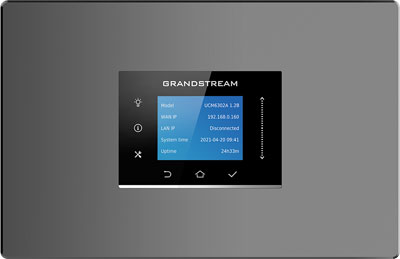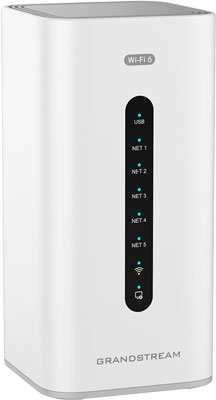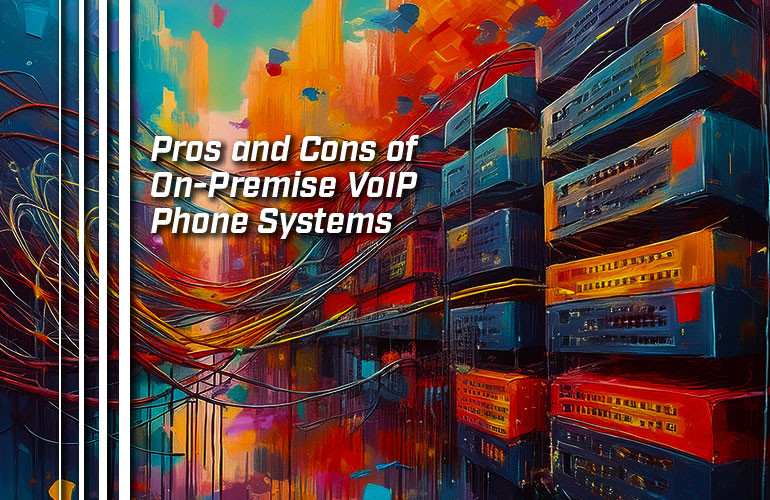VoIP means modern telephony.
The days of telephone wires carrying signals over circuits are coming to a close and the bulky old analog PBXs by Avaya, Mitel, Panasonic, NEC, Nortel, etc. are on their last legs.
Instead, we now use internet technologies to communicate with better audio quality, options like video conferencing, smartphone integration, centralized system management, and much more.
VoIP is a big deal and it’s a good deal.
But you still need to have a VoIP phone system to power your communications.
Are you wanting to switch from an analog or digital PBX system to a modern VoIP phone system? Are you shopping around for the right VoIP phone solution for your business? We’re here to help.
In this blog, we clearly explain the pros and cons of on-premise VoIP phone systems. We compare them with cloud-based phone services. We also touch on open source VoIP phone systems.
Let’s get into it!

On-Premise VoIP Phone System vs Cloud Phone Service
There are two basic types of VoIP phone system: on-premise and cloud-based. (There are also hybrid VoIP phone systems that use parts of both, but we’re going to ignore those.)
The essential difference between on-premise and cloud is who manages the VoIP software and operates the servers that the VoIP phone system is running on: your business or an external company?
An on-premise phone system is owned and operated by your business. You run the phone system on a dedicated device you own — usually called an IP PBX — or a physical server you own or a cloud server you operate.
A cloud phone system is a subscription service owned and operated by an external company. They run the VoIP phone system on their servers and you pay to access it. Think of Spotify or Netflix: You’re streaming the music, you’re streaming the movie, but you don’t own them. It’s pretty much the same thing, except with your communications.
Some examples of cloud phone systems or hosted VoIP services are Microsoft Teams, Zoom Phone, Google Voice by Google Workspace, RingCentral, 8x8, Nextiva, Dialpad, GoTo, Webex Calling, and OnSIP. There are many more cloud VoIP services. There are many different names for what we’re calling cloud phone systems: one in particular to look out for is hosted VoIP. If you see the term “as a Service” or “-aaS” anywhere — like “Unified Communications as a Service” or “UCaaS” — then it’s a cloud-based solution.
Both types of VoIP phone systems have their pros and cons. But they share a lot.
Both types might offer device integration, so you can carry your business account from your computer to your smartphone or tablet. Both types might support unified communications options, like video conferencing, digital whiteboarding, and corporate chat. Both types might have features for specific scenarios like hotels or call centers.
Not every platform — for both on-premise and cloud-based systems — will offer everything, but you can find options of both types that will support features like we just listed.
If you’d like to know more, check out our clear, detailed VoIP Phone Systems Buyer’s Guide.
So why do people choose one or the other? Cloud phone companies tend to grab the headlines, but many businesses choose to go with on-premise telephony solutions.

Pros of On-Premise VoIP Phone Systems
Why do so many companies choose on-premise VoIP phone solutions over cloud-based? Here are some of the main reasons:
Control. With on-premise VoIP, your business controls your communications. You’re not beholden to another company.
Stability. We all know how much tech can change in a short period of time. But you don’t want to get the short stick when it comes to your communications. With an on-premise VoIP ecosystem, you get the reliability that comes with ownership.
Pay per line (in many cases). Cloud-based subscriptions typically charge per user. On-premise systems often, though not always, support certain numbers of lines, which can be used as needed by multiple users. Most of the time a business only needs roughly one-third the number of lines as users. Think about it: How often is everyone on the phone at the same time? So if your business only pays for 10 lines vs 30 users… well, you can do the math.
Lower long-term costs. On-premise VoIP phone systems don’t require on-going subscriptions, whereas cloud systems do. You’re never “done” paying Netflix, are you? But if you buy a Blu-Ray player and a few of your favorite movies, you never have to pay for them again. Same concept, except with your vital communications infrastructure.
Integrate analog lines. Some IP PBXs have FXS or FXO ports — either built-in or available as modules — that allow you to connect analog devices like telephones or run a connection to analog phone lines. This means you can migrate to a VoIP phone system and still use analog phone lines. You can switch to VoIP phone lines at your own speed.
Use your own servers. If you already have a good server setup, why not use it? Run the software yourself on your servers and make use of the tech you’ve already invested in.

Cons of On-Premise VoIP Phone Systems
Of course, it’s not all roses. There are drawbacks to going with an on-premise VoIP phone system.
Scalability. Cloud phone services tend to be more scalable in a fine-grained sense, because you pay by the user. So you can add or subtract users as needed. On the other hand, you always have to pay per user.
Lower initial costs. Because, with cloud VoIP systems, you don’t need specialized hardware, you don’t need to pay for it up front like you do with most on-premise options. This can mean significant short-term savings.
The latest features. Cloud phone services tend to get new features before on-premise phone systems because of market competition driving the companies to offer attractive features. On-premise tends to move slower. And frankly, unless you’re Apple or Amazon, a big player like Microsoft or Zoom will be able to outspend you on communications infrastructure — it’s just true.
Lifespan of hardware. While on-premise systems do offer long-term stability, as with all tech there is an endpoint. Your servers might become obsolete over time or their firmware will no longer be updated. They might fail. The phone system software might no longer be compatible. In which case, you’ll have to buy a new server or a new IP PBX appliance.
Management. With hosted VoIP, you have less to do. If your business doesn’t want the responsibility of managing the phone system, a cloud phone solution is probably best.
License fees. Even with an on-premise system, you may need to pay extra for licenses to enable additional user support, advanced features, and so on. On the other hand, you’ll have to pay more with cloud VoIP as well, either by paying for more users or for escalating to another tier for more features. So it’s kind of a wash — but something you should know about!

Software-Based On-Premise VoIP Phone Systems
We wanted to clarify one thing: software VoIP phone systems.
Many people think that using on-premise VoIP phone system means using a physical IP PBX, which is a dedicated appliance for connecting devices and running the phone system.
But there are also software on-premise VoIP phone systems like 3CX, which offers annual licenses to pay for a given number of per simultaneous calls with options for hotels and call centers features.
You operate the 3CX software on your own servers. The servers might be physical network servers in a rack somewhere in your office or they might be cloud servers that you pay to access. Either way, you’re the one in control.
How is a software on-premise phone system different from a cloud phone system? With the former, you operate the phone system software yourself on your own servers. With the latter, you’re paying for access to software operated by another company on their servers.

What About Open Source VoIP Phone Systems?
To finish, we wanted to touch on open source VoIP platforms.
Nowadays, almost all VoIP phone systems use the SIP protocol. We’re not going to get into what SIP is right now. All you need to know is that it’s an open standard for communications. If you’d like to know more about SIP, check out our blog, “ What Is a SIP Phone? An Easy to Understand Explainer.”
Because SIP is an open standard, it’s not owned by any one company. Some people have run with this idea and developed free, open source SIP solutions. Some of the most popular open source VoIP solutions are Asterisk, FreePBX, and Linphone. (Asterisk and FreePBX are open source VoIP projects sponsored by Sangoma, who make VoIP phones and appliances for these open source VoIP phone systems.)
You can own and operate your own on-premise SIP server using open source VoIP phone system software. With open source SIP solutions, you get the maximum flexibility in terms of what SIP phones you can use — but you’re responsible for getting the phones to work with the system. With most cloud phone services, the company will have a list of compatible phones that, in most cases, you can’t deviate from.
Free? Maximum flexibility? Sounds great!
But.
Know this: Open source VoIP systems require advanced technical expertise and a lot of elbow grease to get things to work. As an example, Asterisk themselves say on their website (external link), “The Asterisk framework itself is built by developers for developers. If you want to create applications and solutions with Asterisk you will need a working knowledge of Linux, script programming, networking and telephony.”
Can your business handle that?
Put short: Unless you (or your sysadmin) know what you’re doing at a deep, technical level, we strongly advise you not to go with an open source solution. In other words, if you know you can handle an open source SIP system, go ahead. If you’re even 0.1% unsure, don’t.

